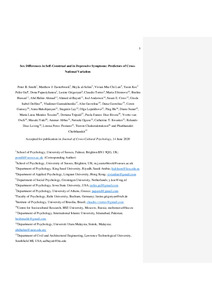Please use this identifier to cite or link to this item:
https://repositorio.uca.edu.ar/handle/123456789/10427| Título: | Sex differences in self-construal and in depressive symptoms : predictors of cross-national variation | Autor: | Smith, Peter B. Easterbrook, Matthew J. Al-Selim, Heyla Lun, Vivian Miu Chi Koc, Yasin Gul, Pelin Papastylianou, Dona Grigoryan, Lusine Torres, Claudio Efremova, Maria Hassan, Bushra Ahmad, Abd Halim Al-Bayati, Ahmed Anderson, Joel Cross, Susan E. Delfino, Gisela Gamsakhurdia, Vladimer Gavreliuc, Alin Gavreliuc, Dana Gunsoy, Ceren Hakobjanyan, Anna Lay, Siugmin Lopukhova, Olga Hu, Ping Sunar, Diane Texeira, Maria Luisa Mendes Tripodi, Doriana Diaz Rivera, Paola Eunice Van Osch, Yvette Yuki, Masaki Abbas, Ammar Ogusu, Natsuki Kwantes, Catherine T. Díaz Loving, Rolando Perez-Floriano, Lorena Chaleeraktrakoon, Trawin Chobthamkit, Phatthanakit |
Palabras clave: | GENERO; AUTOCONCEPTO; CONTEXTO CULTURAL; PERSONALIDAD; DEPRESION | Fecha de publicación: | 2020 | Editorial: | SAGE Publications | Cita: | Smith, P. B., et al. Sex differences in self-construal and in depressive symptoms : predictors of cross-national variation [en línea]. Postprint de artículo publicado en Journal of Cross-Cultural Psychology. 2020. doi:1177/0022022120939655. Disponible en: https://repositorio.uca.edu.ar/handle/123456789/10427 | Resumen: | Abstract: Sex differences in aspects of independent versus interdependent self-construal and depressive symptoms were surveyed among 5,320 students from 24 nations. Men were found to perceive themselves as more self-contained whereas women perceived themselves as more connected to others. No significant sex differences were found on two further dimensions of self-construal, or on a measure of depressive symptoms. Multilevel modelling was used to test the ability of a series of predictors derived from a social identity perspective and from evolutionary theory to moderate sex differences. Contrary to most prior studies of personality, sex differences in self-construal were larger in samples from nations scoring lower on the Gender Gap Index, and the Human Development Index. Sex differences were also greater in nations with higher pathogen prevalence, higher self-reported religiosity, and in nations with high reported avoidance of settings with strong norms. The findings are discussed in terms of the interrelatedness of self-construals and the cultural contexts in which they are elicited and the distinctiveness of student samples. | URI: | https://repositorio.uca.edu.ar/handle/123456789/10427 | ISSN: | 0022-0221 (impreso) 1552-5422 (online) |
Disciplina: | PSICOLOGIA | DOI: | 10.1177/0022022120939655 | Derechos: | Acceso abierto | Fuente: | Journal of Cross-Cultural Psychology. 2020 |
| Appears in Collections: | Artículos |
Files in This Item:
| File | Description | Size | Format | |
|---|---|---|---|---|
| sex-differences-self-construal.pdf | 393,51 kB | Adobe PDF |  View/Open |
Page view(s)
156
checked on Apr 30, 2024
Download(s)
240
checked on Apr 30, 2024
Google ScholarTM
Check
Altmetric
Altmetric
This item is licensed under a Creative Commons License

